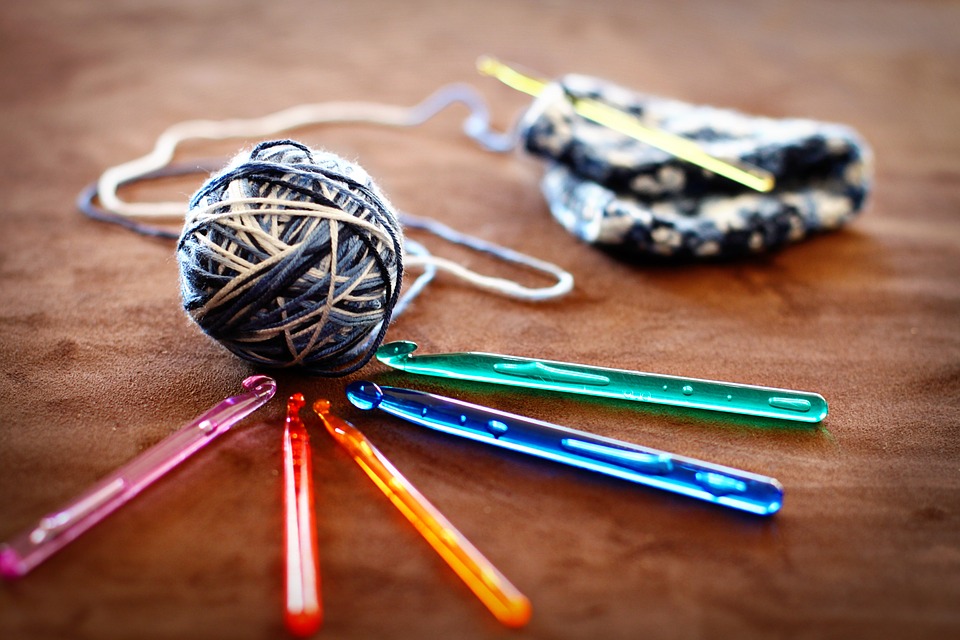by Alison | Crochet Patterns, Crochet Stories, Granny Squares
Granny Jacket Update Number 1
I am making a crochet jacket for the autumn in Vanna’s choice (DK) with a 5mm hook. This jacket will fit a 2x size woman (that’s me) and I will post updates as it goes along.
I want to say I did quite a bit of crocheting at my newly discovered Vancouver knitting Meetup group on the past two Thursday evenings. Where I met some lovely and generous knitters and crocheters.
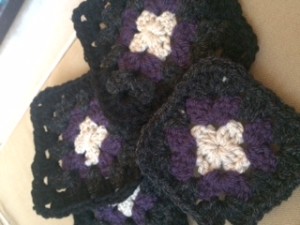
Squares ready for sewing together.
Granny square layout
Here is the diagram for the Granny jacket i’m making with the basic granny square.
As you know I use my journal to capture the ideas as I go. Here is the image of the page in my journal so far.
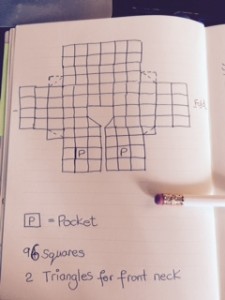
Granny jacket square layout diagram
You need to make 96 squares and two triangles for the front neck. There is also a border but that is not shown on this diagram. This diagram shows the layout of the squares only.
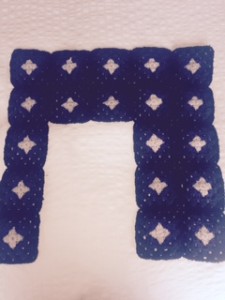
Start of granny jacket showing neck space.
Make two triangles
I’ll get the info on the two triangles that go at the front neck opening soon.
More on the Granny jacket
Author Bio
Alison Heathcote, a passionate crochet enthusiast and dedicated business blogger, combines her love for crafting and entrepreneurship to inspire and connect with others.
With a knack for transforming yarn into beautiful creations and a flair for sharing valuable insights about running a successful crochet business, Alison embodies the perfect blend of creativity and practicality.
More Articles
If you enjoyed this post and crochet is your thing, you may like some other crochet articles from our blog.
by Alison | Crochet as Therapy, Crochet Stories
Making Space for Crochet
Special Places
I have a cherished spot in my home that’s dedicated to my crocheting.
It’s where I spend a lot of my creative time.
At any given moment, you’ll find me working on at least two crochet projects.
One of them is usually a substantial undertaking, like a cozy blanket or an elegant shawl.
The other is a smaller piece, often composed of charming granny squares.
Large and Small Projects
The larger project tends to stay put at home.
It becomes a part of the decor, blending into the cozy atmosphere.
On the other hand, the smaller crochet project is portable, which is a blessing.
I can take it with me wherever I go, and it’s become my trusty companion during moments of waiting.
Waiting Rooms
Whether it’s in a doctor’s waiting room, a dentist’s office, or sitting in the car while waiting for the kids to finish school, my crochet work is a constant presence.
I’ve even brought my small crochet piece to coffee mornings and craft group meetings.
It’s amazing how a few stitches can make those moments more serene and enjoyable.
Stash in Drawers
There was one house we lived in where I had a special drawer in the kitchen exclusively for my yarn and squares. It was a convenient setup.
While waiting for the spaghetti to boil or dinner to cook, I’d pull out my crochet project and make some progress.
It’s incredible how those few moments of crafting can transform mundane kitchen time into a delightful creative escape.
Kitchen Crochet
I must admit that my passion for crochet doesn’t stop even during everyday chores.
You might find me with a ball of yarn peeking out from my apron pocket while I prepare dinner.
It’s almost as if my crochet is a constant companion, adding a touch of artistry to the everyday tasks.
Even when I’m on the phone, I’ve been known to keep my hands busy with my beloved crochet work. It’s not just a hobby; it’s a way of life.
Multitasking
It’s moments like these, when I’m multitasking and weaving my art into the fabric of my daily routine, that I realize the true beauty of crochet.
It’s not just about creating beautiful pieces; it’s about infusing creativity into every corner of my life.
Crocheting is my meditative art, my sanctuary of colors, and my constant companion. I
t brings a sense of calm and joy that’s hard to describe.
Reflection
So, as I reflect on my crocheting journey, I can’t help but smile.
It’s not just about the finished projects; it’s about the process, the moments of waiting, and the everyday life where my love for colors and art shines through.
Crochet is a part of me, and my special place at home is a testament to the love and dedication I have for this wonderful craft.
Author Bio
Alison Heathcote, a passionate crochet enthusiast and dedicated business blogger, combines her love for crafting and entrepreneurship to inspire and connect with others.
With a knack for transforming yarn into beautiful creations and a flair for sharing valuable insights about running a successful crochet business, Alison embodies the perfect blend of creativity and practicality.
More Articles
If you enjoyed this post and crochet is your thing, you may like some other crochet articles from our blog.
by Alison | Crochet Business, Crochet Stories
Many years ago my husband and I owned a baby shop called “Bundle of Joy”.
We sold prams, buggies, bottles, cots, baby clothes, blankets and a million other goodies that a baby needs.
As I was a crocheter I started to create baby blankets to sell in the store.
They did well.
I made crochet baby blankies in white, pink and blue. But never pink and blue together in one blanket.
I made granny squared ones and row on row ones. it was a perfect time of running a business and crocheting at the same time.
I then tried baby yellow and baby green blankets. But they never sold. I could only sell pink or blue blankets.
Our shop attracted customers who were grannies, aunts and mothers of new babies. Over time we got to know the clientele and they would pop in to say “hello” when the went for their groceries at the supermarket in the mall.
During our time at the baby store we were lucky enough to welcome our own bundle of joy and our daughter was born.
So we had a real live baby prop in the store and this too attracted customers.
They would come into our shop and ask, “Do you only have pink or blue blankets?”
To which I responded, “How about this lovely baby mint green or pale lemon?”
Everyone then said, “Oh, I’ll take the pink for my new daughter,” or, “I’ll take the blue because my baby is a boy.”
So even though we could offer a selection of colors, the customers only ever bought the two traditional colours of baby pink and baby blue blankets.
Moms want to clearly define the sex of their baby. If anyone sees a pink or blue blanket in a buggy or pram it is immediately clear that the child is a boy or girl.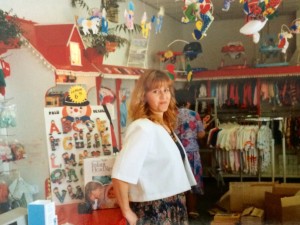
In the three years we had the shops we never sold a yellow or a green blanket but, by having them as a selection to offer our customers, the awkward colored yellow and green blankets helped us sell the pink and blue ones, by them being offered as a choice to our customers.
You can read more on the meaning of colours, selecting colours for your crochet work and soft furnishings.
by Lynn King | Crochet Business, Crochet Stories
by Lynn King
 Kate sewed. She loved sewing.
Kate sewed. She loved sewing.
She made sweat pants for the six month to two year age group.
She sewed up her samples and took orders from her friends and a small order from local kids clothing shop.
It was small potatoes but she kept going. She enjoyed working with her hands.
Kate was retired and had the time to give to her sewing. She only sat at her machine in the day and only when the light was good. She started sewing at 10am and worked until 3pm each day from Monday to Friday.
At first she sewed in the colour and with the cloth she liked. As time went on she took orders for ten blue and ten red sweat pants. these were the popular colours for the pants.
The sweet spot
By buying the cloth in bulk (and getting a little discount from the draper), and making ten blue and red size small, all in one sitting she reached her sweet spot where she could not be any more efficient.
At this stage she could make 19 pants a week. This was not that many really but more than she made as a hobby.
This was how her production was; cutting out on Monday, sewing the main seams on Tuesday, finishing off the garments on Wednesday, pressing the pants on Thursday and packaging and posting her finished items on Friday.
Week in and week out.
It was a case of no work and no pay.
Full production
Now whilst this is good in the short term (six months) there comes a time when you can’t keep up with the orders.
The kid’s shop that took ten a week had a branch in another city and wanted ten for that shop as well.
What to do?
If Kate got sick she couldn’t sew.
She was turning over $40 and making $160 each week at full tilt.
But 19 was all she could make. She could only make nineteen sweatpants a week. If she took a day off she made less money.
Time and money
The realization eventually came to her that she could never make more money – only make less.
That no matter how hard she tried there was a physical limit to how much she could do each week and it all depended on her doing it.
With no one else to help and no more time she could do no more and earn no more money.
And, the sweat pants kept her so busy she couldn’t do the creative wrk that had drawn her to sewing in the first place.
The challenge
It is a challenge faced by many crafters between earning some money, which is important, and being creative and enjoying what you do.
This is known as piece work when you are paid by the item. If there are no items to sell there is no pay for you.
But piecework is an entry into having an independent micro business and this is what attracts many people every year – freedom.
Piecework has its place and can be sustained indefinitely. It is what I recommend to crafters to get them going. Take the plunge and put you crafts out there.
You may also like:
by Alison | Crochet Business, Crochet Stories
by Alison Stapleton
One morning there was an advert in the local newspaper it read,
“Crocheters wanted, meet me at the Table View Mall café at 12 noon on Saturday, Jenny.”
As a crocheter clearly this ad was for me. Wasn’t it?
I duly arrived at the café on the appointed time to find that I was not the only one who could crochet.
There were twenty-five to thirty women chatting and drinking coffee and waiting for noon.

Jenny arrived all suntanned and long blonde hair. She had a bag of little squiggly items and dropped one in front of each of the crocheters.
Then she passed around a little ball of shirring elastic in a variety of colours and gave everyone ten little beads.
The squiggly thing turned out to be a foot ornament worn on the beach with bare feet. It looped over your big toe and then around your ankle. There was assorted African beads on the top as decoration. It was a fun item for summer.
Jenny said to us all, “Make me a sample just like this one and see me back here next Friday at the same time.”
There was a lot of chatter amongst the crocheters and off they went. I went home clutching the sample, elastic and beads.
The pattern was easy to replicate, but the difficult part was working with the shirring elastic. It stretched and I had to try many different sizes of hooks to get the tension just right.
After several attempts, I made what I thought was a good copy of the sample she gave me. I was ready to show my creation to her. I wondered how the other women had got on.
Friday arrived and I was there early with my coffee in front of me waiting for the rush of crocheters.
No one came.
Jenny arrived at five past twelve she saw me and came over to my table. I showed her my work. She liked it. Another woman arrived with her attempt and that too was good.
We were the only ones to bring a sample of our work and the others did not bother.
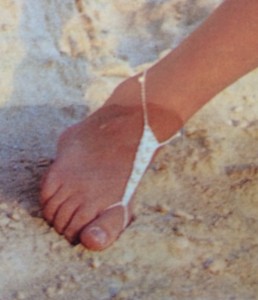
Piecework production
So it began, we would be paid $50 for ten pairs of barefoot sandals which Jenny would sell the at her flea market stall at the Green Market Square for $25 each.
I worked every moment I had spare to get my ten pairs done on time. Not that I had much time with a six month old baby, a toddler of two years and two children aged eight and eleven at school.
On top of this we were renovating the house and had the kitchen in disrepair for months. But I pressed on.
Friday came I met her at the café and she gave me the cash and I gave her the now called “barefoot sandals”.
All this kept going week after week, for six months as the summer wore on.
Jenny’s original designs and her sandy feet were featured in Cosmopolitan magazine and here is a photo of the barefoot sandals I made from the magazine.

This easy casual work eventually ended but it was a good summer for me and the piece work crochet.
What I learnt about piece work
- Piece work is good while it lasts
- You need the skill to do the work.
- You need the time to do the work
by Alison | Crochet Business, Crochet Stories
Joe’s Story
Background
Joe was married and had three kids at school.
Joe’s skill was woodworking.
His talent was crafting wooden doll‘s houses. With having two daughters he had made the first doll’s house when the girls were very young and they had hours of fun playing with it.
Joe worked in a factory. He did not earn much and Christmas was coming.
That year he designed a traditional doll’s house. The roof was painted in magic green and this set off the rustic style of the house beautifully.
The side hinged out so a child could play with the dolls and furniture and live out a fantasy life in miniature.
One year Joe made a sample house and invited the neighbours around to see and hopefully to take orders.
Joe got ten orders for his doll’s house that night. That meant he had four weeks to complete the work. He was excited.
The next Monday be received an order or another five houses from the original people who had seen the sample house, and who had told their friends. And so it was. Joe had verbal orders to build fifteen wooden doll’s houses by Christmas Eve.
He did.
He worked a forty-hour week at the factory and then every evening after dinner he started sawing and nailing wood in his garage. He worked every weeknight until midnight and all day at the weekend.
It took time. Every piece was cut and sanded by hand. The sides were glued and nailed together. The paint had to dry
He took pride in his work.
The Plan
He had bought all the materials he needed to make the houses for around $200. Joe planned to sell them for $20 each. So, his fifteen houses would be (15 x $20 = $300), giving him a profit of $100. This was the plan.
In the end he made the fifteen doll’s houses.
He was paid for ten as he delivered them the day before Christmas Eve but did not get paid for the final five.
Why, because he was too late in delivering them (the plan was Christmas Eve) but the people who had ordered the houses from him got nervous, that they would be let down, and so they bought other gifts for their kids.
That meant they did not have the cash to pay for the doll’s houses they had ordered from Joe.
In the end Joe broke even and was left with five doll’s houses.
Of course he may have broken even in the money numbers, but he was not compensated for all the work he had done for the past four weeks. That effort he was not paid for.
He was tired and had no extra cash for his family for their Christmas meal and gifts.
During the New Year he managed to sell the other houses eventually.
What went wrong?
This happens often that crafts people go into micro businesses (which is what it is if you make things to sell) not fully understanding the time commitment required and how to price correctly for their hand made goods.
Joe could have:
- Taken a deposit for each order
- Delivered the houses one-by-one as they were made
- Charged a bit more for each house
- Got help building the houses
- Made fewer houses, at a better price, that could have been delivered early
How You Can Benefit
You can benefit from Joe’s story in your micro business.
There are a few things you can do to improve how you manage you small craft business and I will discuss them in future posts.
- Your first sale
- How to calculate the true cost of your hand crafted items
- What to charge for your hand crafted goods
- How and why you should take a deposit
- How to respect your skills and charge accordingly
- What to do with the money you make
Author Bio
Alison Heathcote, a passionate crochet enthusiast and dedicated business blogger, combines her love for crafting and entrepreneurship to inspire and connect with others.
With a knack for transforming yarn into beautiful creations and a flair for sharing valuable insights about running a successful crochet business, Alison embodies the perfect blend of creativity and practicality.
More Articles
If you enjoyed this post and crochet is your thing, you may like some other crochet articles from our blog.


















